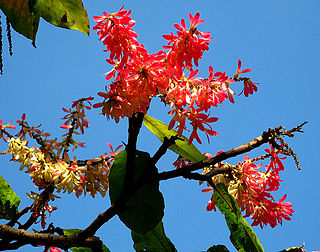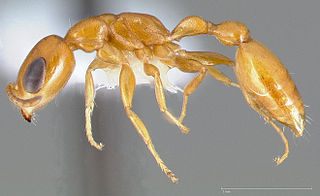
Ants are eusocial insects of the family Formicidae and, along with the related wasps and bees, belong to the order Hymenoptera. Ants evolved from vespoid wasp ancestors in the Cretaceous period. More than 13,800 of an estimated total of 22,000 species have been classified. They are easily identified by their geniculate (elbowed) antennae and the distinctive node-like structure that forms their slender waists.

Venom or zootoxin is a type of toxin produced by an animal that is actively delivered through a wound by means of a bite, sting, or similar action. The toxin is delivered through a specially evolved venom apparatus, such as fangs or a stinger, in a process called envenomation. Venom is often distinguished from poison, which is a toxin that is passively delivered by being ingested, inhaled, or absorbed through the skin, and toxungen, which is actively transferred to the external surface of another animal via a physical delivery mechanism.
Most ants are capable of biting, stinging, and spraying irritant chemicals. However, only relatively few species can harm humans; among which some can cause significant injury or, in rare cases, death. Like wasps, individual ants are capable of stinging multiple times as they do not lose their stingers.

Fire ants are several species of ants in the genus Solenopsis, which includes over 200 species. Solenopsis are stinging ants, and most of their common names reflect this, for example, ginger ants and tropical fire ants. Many of the names shared by this genus are often used interchangeably to refer to other species of ant, such as the term red ant, mostly because of their similar coloration despite not being in the genus Solenopsis. Both Myrmica rubra and Pogonomyrmex barbatus are common examples of non-Solenopsis ants being termed red ants.

Myrmecia is a genus of ants first established by Danish zoologist Johan Christian Fabricius in 1804. The genus is a member of the subfamily Myrmeciinae of the family Formicidae. Myrmecia is a large genus of ants, comprising at least 93 species that are found throughout Australia and its coastal islands, while a single species is only known from New Caledonia. One species has been introduced out of its natural distribution and was found in New Zealand in 1940, but the ant was last seen in 1981. These ants are commonly known as bull ants, bulldog ants or jack jumper ants, and are also associated with many other common names. They are characterized by their extreme aggressiveness, ferocity, and painful stings. Some species are known for the jumping behavior they exhibit when agitated.

The jack jumper ant, also known as the jack jumper, jumping jack, hopper ant, or jumper ant, is a species of venomous ant native to Australia. Most frequently found in Tasmania and southeast mainland Australia, it is a member of the genus Myrmecia, subfamily Myrmeciinae, and was formally described and named by British entomologist Frederick Smith in 1858. This species is known for its ability to jump long distances. These ants are large; workers and males are about the same size: 12 to 14 mm for workers, and 11 to 12 mm for males. The queen measures roughly 14 to 16 mm long and is similar in appearance to workers, whereas males are identifiable by their perceptibly smaller mandibles.

Vachellia collinsii, previously Acacia collinsii, is a species of flowering plant native to Central America and parts of Africa.

Pseudomyrmex spinicola is a species of red myrmecophyte-inhabiting neotropical ants which are found only in Nicaragua and Costa Rica. They live in the thorns of tropical trees like Acacia collinsii or Acacia allenii, feeding on nectaries along with the protein and lipid-rich beltian bodies. These bodies are named for Thomas Belt, a naturalist who first described the interactions between acacias and ants in his 1874 book Naturalist in Nicaragua. Belt's book in fact described ants of this species, then unknown.

Pseudomyrmecinae is a small subfamily of ants containing only three genera of slender, large-eyed arboreal ants, predominantly tropical or subtropical in distribution. In the course of adapting to arboreal conditions, the pseudomyrmecines diversified and came to occupy and retain a much wider geographic range.

Pseudomyrmex leptosus is a species of ant in the genus Pseudomyrmex. It is endemic to certain regions in the United States. The species has completely lost its worker caste.

Pseudomyrmex is a genus of stinging, wasp-like ants in the subfamily Pseudomyrmecinae. They are large-eyed, slender ants, found mainly in tropical and subtropical regions of the New World.

Triplaris is a genus of plants in the family Polygonaceae. Ant tree is a common name for plants in this genus.

A domatium is a tiny chamber that houses arthropods, produced by a plant.

The acacia ant is a species of ant of the genus Pseudomyrmex. These arboreal, wasp-like ants have an orange-brown body around 3 mm in length and very large eyes. The acacia ant is best known and named for living in symbiosis with the bullhorn acacia throughout Central America.

Many species of arthropods can bite or sting human beings. These bites and stings generally occur as a defense mechanism or during normal arthropod feeding. While most cases cause self-limited irritation, medically relevant complications include envenomation, allergic reactions, and transmission of vector-borne diseases.

Pseudomyrmex pallidus is a species of ant found in the Nearctic realm with an extensive range throughout the southern United States to Central America.
Ichthyotoxins are compounds which are either toxic to fish, or are toxins produced by fish. The former include the algae-produced euglenophycin and prymnesins, which can cause large-scale fish deaths. The latter includes ostracitoxin, produced by boxfish. Many toxin-producing algal species can be found both in marine and fresh water environments when the algae are in bloom. Ichthyotoxic poisoning in humans can cause symptoms ranging in severity dependent on how much toxin was consumed. The symptoms of an ichthyotoxin poisoning from fish venoms can include headache, vomiting, diarrhea, dizziness, and drop in blood pressure.

Triplaris americana is a species of flowering plant in the knotweed family known by many common names, including ant tree or pau-formiga, guacamayo, guayabo zancón, hormiguero, palo de Santa María, tachí, vara santa, pau-de-novato, formigueiro, taxizeiro, and devil tree. It is native to Central and South America, occurring from Panama to Brazil. It is also cultivated as an ornamental for its showy pink flowers.

Dinoponera is a strictly South American genus of ant in the subfamily Ponerinae, commonly called tocandiras or giant Amazonian ants. These ants are generally less well known than Paraponera clavata, the bullet ant, yet Dinoponera females may surpass 3–4 cm (1.2–1.6 in) in total body length, making them among the largest ants in the world.
Vitex thyrsiflora is a species of woody vine in the family Lamiaceae. It is native to tropical West and Central Africa. Its hollow stem is used as a home by an aggressive species of ant.














